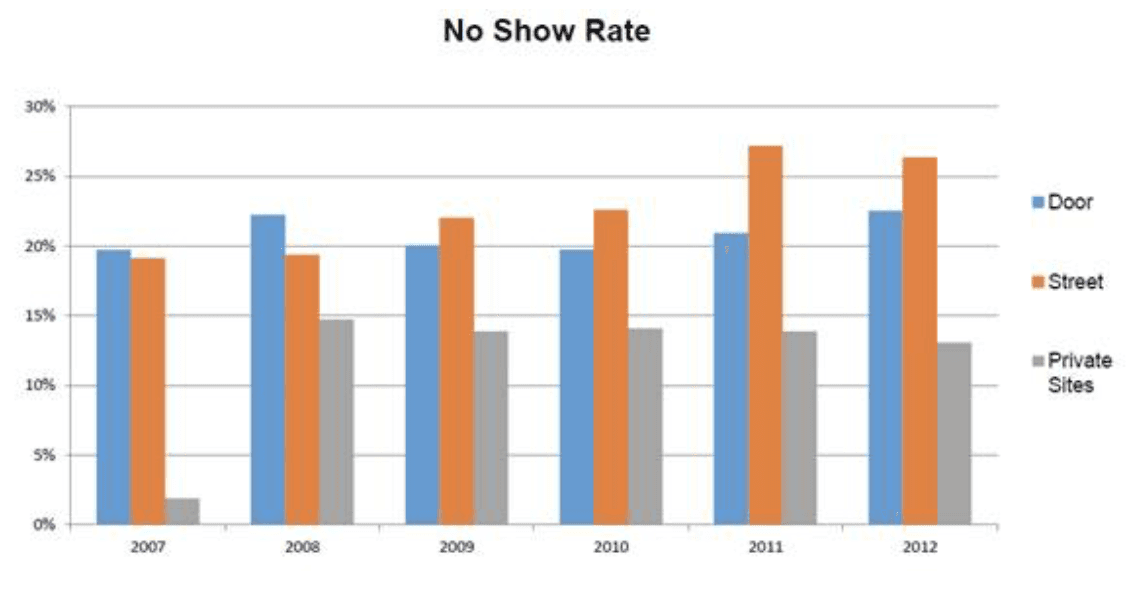CDE project 11f face to face: section 7 — location and integration
- Written by
- The Commission on the Donor Experience
- Added
- March 24, 2017
Location
Face to face fundraising has traditionally taken place on high streets that have been licensed for that purpose or on people’s doorstep. Over the last 5 years, there has been a move to private sites. Shopping centres, railway stations, Ikea stores, WH Smiths, and supermarkets are providing face to face with another platform. The danger here is that the annoyance of face to face is just moving location.
DAR’s ran a report in 2013 claiming that the no Show Rates of the private site recruited donors was a cut above the street and doors:

In terms of location, it is far more important to ensure that you are aligning your brand and charity with a location that can enhance the donor experience. In 2017, St John Ambulance plan to hold face to face fundraising at the events where their volunteers provide the first aid cover. Highlighting the value of their charitable output to the potential donor, who can see their volunteers working as they speak with the fundraiser. The RNLI have taken their face to face fundraising to the beaches during the summer months, Greenpeace, Oxfam, WaterAid, Friends of the Earth have all fundraised at festivals, such as Glastonbury. Home Fundraising delivered a private site campaign for Orbis at Stanstead and Gatwick airports, aligning nicely with the work of their flying doctors.
Agencies and fundraising teams need to work collaboratively on sourcing these private site venues. There will be opportunities to take your face to face program to a location that hasn’t yet been used. It might fit with your brand due to the event it is hosting or the demographic that is attending. The St John Ambulance program mentioned earlier was developed after evidence gained through trials at Twickenham during the six nations, Wimbledon during Wimbledon tennis, and Custom House station during the registration week for all marathon runners, showed that the sign-up rate increased and the retention after 12 months improved by 5% in year one.
Integration
By working with the wider teams within a communications department or across the wider organisation, fundraisers that find themselves managing face to face agencies can build a mass of extra collateral and insight to equip their agencies staff. The benefits this can have for a face to face agencies campaign can be explored and other opportunities opened. Does your Corporate Team have a partner that could give access to a private site for example? Or do you have a gala event where you may have access to potential new regular supporters? Home fundraising have been successfully engaging attendees at a Save the Children event at Royal Albert Hall in recent years. The charities WarChild, Greenpeace, Oxfam, and WaterAid all have face to face teams working at festivals through the summer months, again taking face to face out of the context that many are used to seeing it during the year.
If the site or environment isn't suited to lending weight to your charity or cause, then you can always attempt to create a more attractive engagement. The World Vision story shop that currently can be found at Westfield's shopping centres in London. This offers an interactive experience, as well as drawing potential supporters in to the stand through its aesthetic appeal. This completely flips the typical challenge face to face fundraisers face, as supporters cross the road, or pretend to be on their mobile phones to avoid being stopped.
As Ken Burnett pointed out in the blog reference earlier, when meeting agency staff on a retreat;
“I’m talking about professional face-to-face fundraisers. They’re the people who talk to our potential new donors, one by one, on the street. They’re the people who other professional fundraisers commission to engage, entice and persuade new donors to sign direct debits using this recently established though thoroughly tested mass communication method that many fundraising managers disdain, looking down their noses at it as if it smells. “As I heard the group’s stories of client abuses and lack of support and these realisations dawned, suddenly I felt ashamed of myself and my profession.”
If we don’t integrate and ‘partner’ with those fundraising on our behalf, then what do we expect to be the outcome of a campaign that we paying for? When hiring an agency to work with you, you “have” to work with them. Lobbying your senior managers to spend time with face to face agencies is key. Senior managers have been heard referring to face to face as chugging, implying that it is a necessary evil to generate income, but not spending the time and personal investment they might afford other agencies that they employ. By encouraging senior figures to engage, and pushing back against any slurs, we need to be asking SMT members to start stepping in to the shoes of a face to face fundraiser for just one day. This can change your attitude, and those that your peers might have. I strongly suggest that if anyone within the charity is not supportive of face to face, that you challenge their point-of-view, and get them to do it for a day. Engaging fully with the work that the face to face fundraisers are carrying out for you.
When UNICEF integrated their communications, they had people approaching their face to face teams, hear Louis Lane and Sinéad Chapman present their case study here.


















